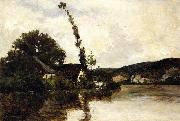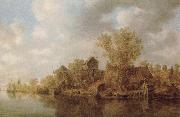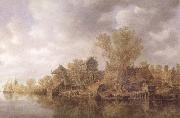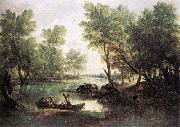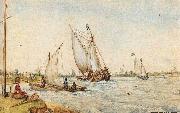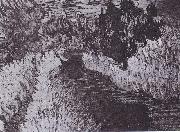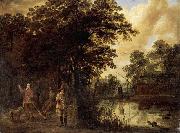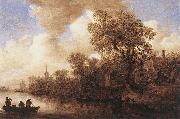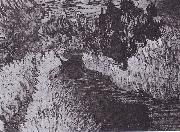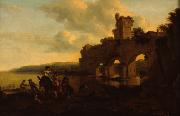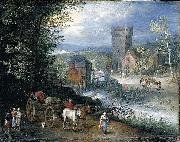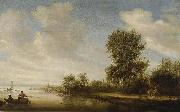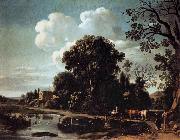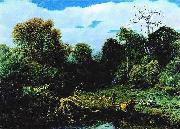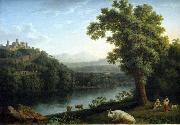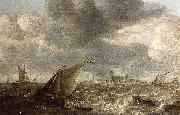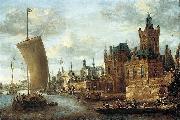Wholesale Oil Painting No Minimum |
|||||||||||
|
|
|||||||||||

|
|||||||||||
|
|
|
||||||||
Jan van Goyen1596-1656 Dutch Jan van Goyen Galleries Dutch landscape painter. He studied at Leiden and Haarlem. In 1631 he settled at The Hague. His typically Dutch landscapes of harbors, canals, riverbanks, and winter scenes with skaters and sleighs are naturalistically painted in a grayish-green tonality. He was one of the first landscape painters to sacrifice minute detail for atmospheric effect and space, and he had a considerable influence on later Dutch landscapists. His paintings are in many collections in Europe and the United States. Famous examples are Panorama of The Hague (The Hague); Banks of a Canal (Louvre); and View of Dordrecht (Rijks Mus.). The Metropolitan Museum has five of van Goyen's works, and the Pennsylvania Academy, two. |
||||||||
|
|
||||||||
River Landscape
River Landscape Painting ID:: 1905 |
1625
Kunsthaus, Zurich 1625 Kunsthaus, Zurich |
|||||||
|
|
||||||||
Hugh Bolton JonesAmerican Painter, 1848-1927 |
||||||||
|
|
||||||||
|
|
River Landscape
River Landscape Painting ID:: 4224 |
|
||||||
|
|
||||||||
Charles-Francois DaubignyFrench Barbizon School Painter, 1817-1878 was one of the painters of the Barbizon school, and is considered an important precursor of Impressionism. Daubigny was born into a family of painters and was taught the art by his father Edmond François Daubigny and his uncle, miniaturist Pierre Daubigny. Initially Daubigny painted in a traditional style, but this changed after 1843 when he settled in Barbizon to work outside in nature. Even more important was his meeting with Camille Corot in 1852 in Optevoz (Is??re). On his famous boat Botin, which he had turned into a studio, he painted along the Seine and Oise, often in the region around Auvers. From 1852 onward he came under the influence of Gustave Courbet. In 1866 Daubigny visited England, eventually returning because of the Franco-Prussian war in 1870. In London he met Claude Monet, and together they left for the Netherlands. Back in Auvers, he met Paul Cezanne, another important impressionist. |
||||||||
|
|
||||||||
|
|
River Landscape
River Landscape Painting ID:: 10512 |
1876Oil on panel
39 x 57 cm 1876Oil on panel 39 x 57 cm |
||||||
|
|
||||||||
Jan van GoyenDutch Baroque Era Painter, 1596-1656 Jan van Goyen was born in Leiden on Jan. 13, 1596. Apprenticed from the age of 10, he had several masters. About 1617 he went to Haarlem to study with Esaias van de Velde, an important innovator in the Haarlem movement of realistic landscape painting. Van Goyen's works between 1621 and 1625 are sometimes hard to distinguish from those of his teacher. They are colorful, detailed views of villages and roads, usually busy with people, as in Winter (1621). It was Van Goyen's usual practice to sign or monogram and date his paintings. He traveled extensively through the Netherlands and beyond, recording his impressions in sketchbooks, occasionally with dates and often depicting recognizable scenes. Thus the chronology of his development is clear. His paintings of the late 1620s show a steady advance from the strong colors and scattered organization of his early works toward tonality and greater simplicity and unity of composition. By 1630 he was painting monochromes in golden brown or pale green; he played a leading part in the tonal phase of Dutch landscape painting. In 1631 Van Goyen settled in The Hague, where he became a citizen in 1634. The simplicity, airiness, and unification of his compositions continued to increase in his abundant production of dune landscapes, river views, seascapes, town views, and winter landscapes. The River View (1636) displays a river so open and extensive as to suggest the sea, with reflections that prolong the vast and luminous sky. In its monumentalization of humble structures and its composition built on a firm scaffolding of horizontal and vertical forces, it forecast at this early date developments that dominated landscape painting in the 1650s and later. In the Village and Dunes (1647) the traditional double-diagonal composition still exists, but it is dominated by horizontal and vertical accents. Stronger contrasts of light and dark replace the earlier tonality. In the last year of his life Van Goyen produced an eloquent new style, in which powerful forms stand out against the radiant sky and water in an exquisitely balanced composition (Evening Calm; 1656). The commission in 1651 to paint a panoramic view of The Hague for the Burgomaster's Room shows the high regard in which Van Goyen was held. He was enormously productive; well over 1,000 of his paintings still exist, and almost as many drawings. |
||||||||
|
|
||||||||
|
|
River Landscape
River Landscape Painting ID:: 33691 |
mk86
1636
Oil on panel
39.5x60cm
Munich,Bayerische Staatsgemalde-sammlungen,
Alte Pinakothek
mk86 1636 Oil on panel 39.5x60cm Munich,Bayerische Staatsgemalde-sammlungen, Alte Pinakothek |
||||||
|
|
||||||||
Jan van Goyen1596-1656 Dutch Jan van Goyen Galleries Dutch landscape painter. He studied at Leiden and Haarlem. In 1631 he settled at The Hague. His typically Dutch landscapes of harbors, canals, riverbanks, and winter scenes with skaters and sleighs are naturalistically painted in a grayish-green tonality. He was one of the first landscape painters to sacrifice minute detail for atmospheric effect and space, and he had a considerable influence on later Dutch landscapists. His paintings are in many collections in Europe and the United States. Famous examples are Panorama of The Hague (The Hague); Banks of a Canal (Louvre); and View of Dordrecht (Rijks Mus.). The Metropolitan Museum has five of van Goyen's works, and the Pennsylvania Academy, two. |
||||||||
|
|
||||||||
|
|
River Landscape
River Landscape Painting ID:: 40448 |
mk156
1636
Oil on panel
39.5x60cm
mk156 1636 Oil on panel 39.5x60cm |
||||||
|
|
||||||||
Jan josephsz van goyenDutch , Leyden 1596-The Hague 1656 was a Dutch landscape painter. Van Goyen was an extremely prolific artist; approximately twelve hundred paintings and more than one thousand drawings by him are known. Jan van Goyen was the son of a shoemaker and started as an apprentice in Leiden. Like many Dutch painters of his time, Jan van Goyen studied art in the town of Haarlem with Esaias van de Velde. At age 35, he established a permanent studio at Den Haag (The Hague). Crenshaw tells (and mentions the sources) that Van Goyen's landscape paintings rarely fetched high prices, but he made up for the modest value of individual pieces by increasing his production, painting thinly and quickly with a limited palette of inexpensive pigments. Despite his market innovations, he always sought more income, not only through related work as an art dealer and auctioneer but also by speculating in tulips and real estate. Although the latter was usually a safe avenue of investing money, in Van Goyen's experience it led to enormous debts. Paulus Potter rented one of his houses. Nicolaes van Berchem became his pupil. In 1652 and 1654 he was forced to sell his collection of paintings and graphic art, and he subsequently moved to a smaller house. He died in 1656, still unbelievably 18,000 guilders in debt, forcing his widow to sell their remaining furniture and paintings. |
||||||||
|
|
||||||||
|
|
River Landscape
River Landscape Painting ID:: 55751 |
mk244
1636
Oil on panel
39.5x60cm
mk244 1636 Oil on panel 39.5x60cm |
||||||
|
|
||||||||
Thomas Gainsborough1727-1788 British Thomas Gainsborough Locations English painter, draughtsman and printmaker. He was the contemporary and rival of Joshua Reynolds, who honoured him on 10 December 1788 with a valedictory Discourse (pubd London, 1789), in which he stated: If ever this nation should produce genius sufficient to acquire to us the honourable distinction of an English School, the name of Gainsborough will be transmitted to posterity, in the history of Art, among the very first of that rising name. He went on to consider Gainsborough portraits, landscapes and fancy pictures within the Old Master tradition, against which, in his view, modern painting had always to match itself. Reynolds was acknowledging a general opinion that Gainsborough was one of the most significant painters of their generation. Less ambitious than Reynolds in his portraits, he nevertheless painted with elegance and virtuosity. He founded his landscape manner largely on the study of northern European artists and developed a very beautiful and often poignant imagery of the British countryside. By the mid-1760s he was making formal allusions to a wide range of previous art, from Rubens and Watteau to, eventually, Claude and Titian. He was as various in his drawings and was among the first to take up the new printmaking techniques of aquatint and soft-ground etching. Because his friend, the musician and painter William Jackson (1730-1803), claimed that Gainsborough detested reading, there has been a tendency to deny him any literacy. He was, nevertheless, as his surviving letters show, verbally adept, extremely witty and highly cultured. He loved music and performed well. He was a person of rapidly changing moods, humorous, brilliant and witty. At the time of his death he was expanding the range of his art, having lived through one of the more complex and creative phases in the history of British painting. He painted with unmatched skill and bravura; while giving the impression of a kind of holy innocence, he was among the most artistically learned and sophisticated painters of his generation. It has been usual to consider his career in terms of the rivalry with Reynolds that was acknowledged by their contemporaries; while Reynolds maintained an intellectual and academic ideal of art, Gainsborough grounded his imagery on contemporary life, maintaining an aesthetic outlook previously given its most powerful expression by William Hogarth. His portraits, landscapes and subject pictures are only now coming to be studied in all their complexity; having previously been viewed as being isolated from the social, philosophical and ideological currents of their time, they have yet to be fully related to them. It is clear, however, that his landscapes and rural pieces, and some of his portraits, were as significant as Reynolds acknowledged them to be in 1788. |
||||||||
|
|
||||||||
|
|
River Landscape
River Landscape Painting ID:: 58907 |
River Landscape
River Landscape |
||||||
|
|
||||||||
AVERCAMP, HendrickDutch Baroque Era Painter, 1585-1634 1634). He was the first artist in the northern Netherlands to paint winter landscapes. Before him only a few Flemish artists, among them Pieter Bruegel I and his sons, and Jacob Grimmer, had made winter scenery the main subject of their work. Avercamp created a new genre of Dutch painting by combining the panoramic scope, bright colours and high vantage point of these Flemish models with an emphasis on anecdotal detail. |
||||||||
|
|
||||||||
|
|
River Landscape
River Landscape Painting ID:: 64189 |
Pen drawing and watercolour on paper, 184 x 284 mm Musees Royaux des Beaux-Arts, Brussels After an apprenticeship in Amsterdam with portrait and historical painter Pieter Isaacsz., Hendrick Avercamp began to specialise in painting winter landscapes. In composing these he drew on a large supply of sketches of individual figures drawn from life. These rapid sketches of people going about their daily activities and pastimes on the ice or in the open field also served for composing, back in the studio, more developed, coloured drawings such as this River Landscape. His lively pen, the bright colour contrasts and the spatial continuity between the foreground and middle ground provide this scene with a freshness characteristic of the innovative middle period of Avercamp's career. The drawing attracts us with its narrative and realistic style. It is also very ingeniously structured, as can be seen in the skilful positioning of the man on the shore in the left-hand foreground, and in the lively interaction between the wind-swelled sails of the smaller and larger ships. The fishermen look on motionless, revealing the sober, at times humorous but never mocking eye that Avercamp casts on his surroundings. The contours of the figures are drawn in pen and the intervening space is carefully filled in with water colour and bodycolour. Avercamp probably borrowed the use of aquarelle and gouache from Jan Brueghel the Elder and the Flemish emigrants living in Amsterdam, such as Hans Bol, Jacob Savery and David Vinckboons, whose works he had got to know during his apprenticeship with Pieter Isaacsz. Avercamp was one of the first Dutch draughtsmen who in the early 17th century developed this aquarelle technique specifically as a separate, independent art form. His pen drawings, illuminated with water colours, were so carefully finished and richly detailed that they were highly sought after by connoisseurs and art lovers. Indeed some were not, as was customary, kept in albums, but glued to panels and framed, and hung as a cheap alternative to paintings. Avercamp directed his efforts not only at the local art market in and around Kampen, but also and in particular at that of Amsterdam, where, according to contemporary documents, he was held in high renown. , Artist: AVERCAMP, Hendrick , River Landscape , 1601-1650 , Dutch , graphics , landscape Pen drawing and watercolour on paper, 184 x 284 mm Musees Royaux des Beaux-Arts, Brussels After an apprenticeship in Amsterdam with portrait and historical painter Pieter Isaacsz., Hendrick Avercamp began to specialise in painting winter landscapes. In composing these he drew on a large supply of sketches of individual figures drawn from life. These rapid sketches of people going about their daily activities and pastimes on the ice or in the open field also served for composing, back in the studio, more developed, coloured drawings such as this River Landscape. His lively pen, the bright colour contrasts and the spatial continuity between the foreground and middle ground provide this scene with a freshness characteristic of the innovative middle period of Avercamp's career. The drawing attracts us with its narrative and realistic style. It is also very ingeniously structured, as can be seen in the skilful positioning of the man on the shore in the left-hand foreground, and in the lively interaction between the wind-swelled sails of the smaller and larger ships. The fishermen look on motionless, revealing the sober, at times humorous but never mocking eye that Avercamp casts on his surroundings. The contours of the figures are drawn in pen and the intervening space is carefully filled in with water colour and bodycolour. Avercamp probably borrowed the use of aquarelle and gouache from Jan Brueghel the Elder and the Flemish emigrants living in Amsterdam, such as Hans Bol, Jacob Savery and David Vinckboons, whose works he had got to know during his apprenticeship with Pieter Isaacsz. Avercamp was one of the first Dutch draughtsmen who in the early 17th century developed this aquarelle technique specifically as a separate, independent art form. His pen drawings, illuminated with water colours, were so carefully finished and richly detailed that they were highly sought after by connoisseurs and art lovers. Indeed some were not, as was customary, kept in albums, but glued to panels and framed, and hung as a cheap alternative to paintings. Avercamp directed his efforts not only at the local art market in and around Kampen, but also and in particular at that of Amsterdam, where, according to contemporary documents, he was held in high renown. , Artist: AVERCAMP, Hendrick , River Landscape , 1601-1650 , Dutch , graphics , landscape |
||||||
|
|
||||||||
Vincent Van GoghDutch Post-Impressionist Painter, 1853-1890 Vincent Willem van Gogh (30 March 1853 ?C 29 July 1890) was a Dutch Post-Impressionist artist. Some of his paintings are now among the world's best known, most popular and expensive works of art. Van Gogh spent his early adult life working for a firm of art dealers. After a brief spell as a teacher, he became a missionary worker in a very poor mining region. He did not embark upon a career as an artist until 1880. Initially, Van Gogh worked only with sombre colours, until he encountered Impressionism and Neo-Impressionism in Paris. He incorporated their brighter colours and style of painting into a uniquely recognizable style, which was fully developed during the time he spent at Arles, France. He produced more than 2,000 works, including around 900 paintings and 1,100 drawings and sketches, during the last ten years of his life. Most of his best-known works were produced in the final two years of his life, during which time he cut off part of his left ear following a breakdown in his friendship with Paul Gauguin. After this he suffered recurrent bouts of mental illness, which led to his suicide. The central figure in Van Gogh's life was his brother Theo, who continually and selflessly provided financial support. Their lifelong friendship is documented in numerous letters they exchanged from August 1872 onwards. Van Gogh is a pioneer of what came to be known as Expressionism. He had an enormous influence on 20th century art, especially on the Fauves and German Expressionists. |
||||||||
|
|
||||||||
|
|
River landscape
River landscape Painting ID:: 85649 |
Date Auvers, June 1890
Medium Oil on canvas
Dimensions 25,5 x 40 cm
cjr Date Auvers, June 1890 Medium Oil on canvas Dimensions 25,5 x 40 cm cjr |
||||||
|
|
||||||||
Pieter Meulenerpainted River Landscape in 1651 |
||||||||
|
|
||||||||
|
|
River Landscape
River Landscape Painting ID:: 86775 |
Date 1651(1651)
Medium Oil on panel transferred to canvas
Dimensions Height: 45 cm (17.7 in). Width: 59 cm (23.2 in).
cjr Date 1651(1651) Medium Oil on panel transferred to canvas Dimensions Height: 45 cm (17.7 in). Width: 59 cm (23.2 in). cjr |
||||||
|
|
||||||||
Jan van GoyenDutch Baroque Era Painter, 1596-1656 Jan van Goyen was born in Leiden on Jan. 13, 1596. Apprenticed from the age of 10, he had several masters. About 1617 he went to Haarlem to study with Esaias van de Velde, an important innovator in the Haarlem movement of realistic landscape painting. Van Goyen's works between 1621 and 1625 are sometimes hard to distinguish from those of his teacher. They are colorful, detailed views of villages and roads, usually busy with people, as in Winter (1621). It was Van Goyen's usual practice to sign or monogram and date his paintings. He traveled extensively through the Netherlands and beyond, recording his impressions in sketchbooks, occasionally with dates and often depicting recognizable scenes. Thus the chronology of his development is clear. His paintings of the late 1620s show a steady advance from the strong colors and scattered organization of his early works toward tonality and greater simplicity and unity of composition. By 1630 he was painting monochromes in golden brown or pale green; he played a leading part in the tonal phase of Dutch landscape painting. In 1631 Van Goyen settled in The Hague, where he became a citizen in 1634. The simplicity, airiness, and unification of his compositions continued to increase in his abundant production of dune landscapes, river views, seascapes, town views, and winter landscapes. The River View (1636) displays a river so open and extensive as to suggest the sea, with reflections that prolong the vast and luminous sky. In its monumentalization of humble structures and its composition built on a firm scaffolding of horizontal and vertical forces, it forecast at this early date developments that dominated landscape painting in the 1650s and later. In the Village and Dunes (1647) the traditional double-diagonal composition still exists, but it is dominated by horizontal and vertical accents. Stronger contrasts of light and dark replace the earlier tonality. In the last year of his life Van Goyen produced an eloquent new style, in which powerful forms stand out against the radiant sky and water in an exquisitely balanced composition (Evening Calm; 1656). The commission in 1651 to paint a panoramic view of The Hague for the Burgomaster's Room shows the high regard in which Van Goyen was held. He was enormously productive; well over 1,000 of his paintings still exist, and almost as many drawings. |
||||||||
|
|
||||||||
|
|
River Landscape
River Landscape Painting ID:: 87935 |
Date 1652
Medium Oil on oak panel
Dimensions 66.7 x 98 cm (26.3 x 38.6 in)
cjr Date 1652 Medium Oil on oak panel Dimensions 66.7 x 98 cm (26.3 x 38.6 in) cjr |
||||||
|
|
||||||||
Vincent Van GoghDutch Post-Impressionist Painter, 1853-1890 Vincent Willem van Gogh (30 March 1853 ?C 29 July 1890) was a Dutch Post-Impressionist artist. Some of his paintings are now among the world's best known, most popular and expensive works of art. Van Gogh spent his early adult life working for a firm of art dealers. After a brief spell as a teacher, he became a missionary worker in a very poor mining region. He did not embark upon a career as an artist until 1880. Initially, Van Gogh worked only with sombre colours, until he encountered Impressionism and Neo-Impressionism in Paris. He incorporated their brighter colours and style of painting into a uniquely recognizable style, which was fully developed during the time he spent at Arles, France. He produced more than 2,000 works, including around 900 paintings and 1,100 drawings and sketches, during the last ten years of his life. Most of his best-known works were produced in the final two years of his life, during which time he cut off part of his left ear following a breakdown in his friendship with Paul Gauguin. After this he suffered recurrent bouts of mental illness, which led to his suicide. The central figure in Van Gogh's life was his brother Theo, who continually and selflessly provided financial support. Their lifelong friendship is documented in numerous letters they exchanged from August 1872 onwards. Van Gogh is a pioneer of what came to be known as Expressionism. He had an enormous influence on 20th century art, especially on the Fauves and German Expressionists. |
||||||||
|
|
||||||||
|
|
River landscape
River landscape Painting ID:: 89884 |
Auvers, June 1890
Medium oil on canvas
Dimensions 25,5 x 40 cm
cyf Auvers, June 1890 Medium oil on canvas Dimensions 25,5 x 40 cm cyf |
||||||
|
|
||||||||
Nicolaes Pietersz. Berchem(1 October 1620 - 18 February 1683) was a highly esteemed and prolific Dutch Golden Age painter of pastoral landscapes, populated with mythological or biblical figures, but also of a number of allegories and genre pieces. Born in Haarlem, he received instruction from his father Pieter Claesz, and from the painters Jan van Goyen, Pieter de Grebber, Jan Baptist Weenix, Jan Wils and Claes Cornelisz. Moeyaert.According to Houbraken, Carel de Moor told him that Berchem got his name from two words "Berg hem" for "Save him!", an expression used by his fellows in Van Goyen's workshop whenever his father chased him there with the intent to beat him. No trip or Grand Tour by Berchem was documented by Houbraken though he mentioned another story about the "Berg hem!" nickname which came from Berchem's conscription as a sailor; the man in charge of impressment knew him and sent him ashore with the words "Save him!".Today his name is assumed to come from his father's hometown of Berchem, Antwerp. According to the RKD he traveled to Italy with Jan Baptist Weenix, whom he called his cousin, in 1642-5. Works by him are signed both as "CBerghem" and "Berchem". |
||||||||
|
|
||||||||
|
|
River Landscape
River Landscape Painting ID:: 90670 |
between 1642(1642) and 1683(1683)
Medium oil on panel
Dimensions 45.7 x 68.6 cm (18 x 27 in)
cjr between 1642(1642) and 1683(1683) Medium oil on panel Dimensions 45.7 x 68.6 cm (18 x 27 in) cjr |
||||||
|
|
||||||||
Pieter GijselsFlemish painter (b. 1621, Antwerpen, d. 1690, Antwerpen |
||||||||
|
|
||||||||
|
|
River Landscape
River Landscape Painting ID:: 91120 |
second half of 17th century
Medium oil on oak panel
Dimensions Height: 18 cm (7.1 in). Width: 23 cm (9.1 in).
cyf second half of 17th century Medium oil on oak panel Dimensions Height: 18 cm (7.1 in). Width: 23 cm (9.1 in). cyf |
||||||
|
|
||||||||
Salomon van RuysdaelSalomon van Ruysdael (c. 1602, Naarden - buried Nov 3, 1670, Haarlem) was a Dutch landscape painter. He was the uncle of Jacob van Ruisdael. |
||||||||
|
|
||||||||
|
|
River landscape
River landscape Painting ID:: 92778 |
1642(1642)
Medium oil on oak
Dimensions 52 X 83 cm (20.5 X 32.7 in)
cjr 1642(1642) Medium oil on oak Dimensions 52 X 83 cm (20.5 X 32.7 in) cjr |
||||||
|
|
||||||||
Filippo Napoletano(c. 1587 - November 1629) was an Italian artist, with a peculiar output, mainly landscape and genre scenes and also drawings or etchings of diverse, often particular, items such as exotic soldiers, skeletons of animals, or cityscapes. He began his career in his native city, Naples (1600-1613) and moved to Rome in 1614-1617), where he appears to have encountered and felt influenced by the successful Flemish landscape painters such as Paul Bril, Goffredo Wals, and Adam Elsheimer. In 1617 Cosimo II dee Medici summoned him to Florence, where he worked closely with Jacques Callot. From notebooks, Filippo is known to have made hundreds of sketches of Tuscan landscapes and towns. Starting in 1620 he reproduced in etchings part of his collection of animal skeletons owned by Johann Faber, a Bavarian physician-naturalist residing in Rome and a member of the scientific Accademia dei Lincei. In 1622, Napoletano published twelve etchings of caprices (capprici) and military uniforms (which he signed as signed Teodor Filippo de Liagno). He is described by Giovanni Baglione as possessing a collection, a Wunderkammer of bellissime bizzarrie ("beautiful bizarre objects"), including among the objects exotic weaponry; fossilized plants; tiger, lion, and turtle skulls; oriental porcelain and sculpted crockery; a vest made of human skin; a harness for dragging whales on ice; a three-legged flea, Persian uniforms, and antiquities such as Roman coins, bronze lamps, and a few statuettes. After Napoletano death at Rome in 1628, bidding for such material was made by collectors such as Cardinal Ippolito Aldobrandini (future Clement VIII) and Cassiano dal Pozzo. |
||||||||
|
|
||||||||
|
|
River Landscape
River Landscape Painting ID:: 95800 |
between 1617(1617) and 1621(1621)
Medium oil on canvas
cyf between 1617(1617) and 1621(1621) Medium oil on canvas cyf |
||||||
|
|
||||||||
William-Adolphe Bouguereau(November 30, 1825 - August 19, 1905) was a French academic painter. William Bouguereau was a traditionalist whose realistic genre paintings and mythological themes were modern interpretations of Classical subjects with a heavy emphasis on the female human body. William-Adolphe Bouguereau was born in La Rochelle, France on November 30, 1825, into a family of wine and olive oil merchants. He seemed destined to join the family business but for the intervention of his uncle Eugene, a Roman Catholic priest, who taught him classical and Biblical subjects, and arranged for Bouguereau to go to high school. Bouguereau showed artistic talent early on and his father was convinced by a client to send him to the École des Beaux-Arts in Bordeaux, where he won first prize in figure painting for a depiction of Saint Roch. To earn extra money, he designed labels for jams and preserves |
||||||||
|
|
||||||||
|
|
River landscape
River landscape Painting ID:: 96704 |
1850(1850)
Medium oil on panel
Dimensions 33.5 X 46.2 cm
cyf 1850(1850) Medium oil on panel Dimensions 33.5 X 46.2 cm cyf |
||||||
|
|
||||||||
Jacob Philipp Hackert(September 15, 1737 - April 28, 1807) was a landscape painter from Brandenburg, who did most of his work in Italy. Hackert was born in 1737 in Prenzlau in the Margraviate of Brandenburg (now in Germany). He trained with his father Philipp (a portraitist and painter of animals) and his uncle, before going to the Akademie der Kenste in Berlin in 1758. Later he traveled to Swedish Pomerania and Stockholm, where he painted murals. He spent from 1765 to 1768 in Paris, with the Swiss Artist, Balthasar Anton Dunker, where he focused on painting in gouache. He met and was inspired by Claude Joseph Vernet, who was already famous as a painter of landscapes and seascapes, and the German engraver Johann Georg Wille. In 1768 Hackert left Paris with his brother Georg, and went to Italy, basing himself mainly in Rome and Naples, where he produced many works for Sir William Hamilton. He travelled all over Italy, gaining a reputation as a talented landscape painter. In 1786 he went to work for Ferdinand I of the Two Sicilies in Naples. He advised on the creation of a painting restoration laboratory at the Museo di Capodimonte, and supervised the transfer of the Farnese collections from Rome to Naples. By this time he had an international reputation, and won commissions from empress Catherine II of Russia, king Louis XVI of France and others. When Goethe visited Naples in 1786, he and Hackert became friends. |
||||||||
|
|
||||||||
|
|
River Landscape
River Landscape Painting ID:: 98383 |
1805(1805) 1805(1805) |
||||||
|
|
||||||||
Abraham van Beijeren(ca. 1620 - March 1690) was a Dutch Baroque era painter. He was little regarded in his day but is now considered one of the greatest of still-life painters. Van Beijeren (alternatively spelled "Beyeren") lived in a succession of Dutch towns. Born in The Hague, the artist also lived in Delft, Amsterdam, Alkmaar and Gouda. In 1678 he settled in Rotterdam, where he died in 1690. |
||||||||
|
|
||||||||
|
|
River Landscape
River Landscape Painting ID:: 98428 |
second half of 17th century
Medium oil on panel
Dimensions Height: 61 cm (24 in). Width: 94 cm (37 in).
second half of 17th century Medium oil on panel Dimensions Height: 61 cm (24 in). Width: 94 cm (37 in). |
||||||
|
|
||||||||
Jacobus Storck(1641 - c.1700) was a Dutch Golden Age marine painter. Storck was born and died in Amsterdam. According to Houbraken he was the brother of the marine painter Abraham Storck who painted views of the Rhine and inland ships, but who was not as gifted. According to the RKD he was the second son of the marine painter Johannes Sturckenburgh, younger brother of the marine painter Johannes Storck and older brother of Abraham. Signed works by him are dated 1664-1687. He sometimes signed JA Storck, which since 1963 has been interpreted as a work by both Jacobus and Abraham together. |
||||||||
|
|
||||||||
|
|
River Landscape
River Landscape Painting ID:: 98439 |
second half of 17th century
Medium oil on canvas
Dimensions Height: 66 cm (26 in). Width: 97 cm (38.2 in).
second half of 17th century Medium oil on canvas Dimensions Height: 66 cm (26 in). Width: 97 cm (38.2 in). |
||||||
|
|
||||||||
|
Jacobus Storck (1641 - c.1700) was a Dutch Golden Age marine painter. Storck was born and died in Amsterdam. According to Houbraken he was the brother of the marine painter Abraham Storck who painted views of the Rhine and inland ships, but who was not as gifted. According to the RKD he was the second son of the marine painter Johannes Sturckenburgh, younger brother of the marine painter Johannes Storck and older brother of Abraham. Signed works by him are dated 1664-1687. He sometimes signed JA Storck, which since 1963 has been interpreted as a work by both Jacobus and Abraham together. River Landscape second half of 17th century Medium oil on canvas Dimensions Height: 66 cm (26 in). Width: 97 cm (38.2 in). |
||||||||
|
|
||||||||
|
Prev Next
|
||||||||
|
|
||||||||
|
Related Paintings to Jacobus Storck :. |
||||||||
|
|
||||||||
|
CONTACT US |



